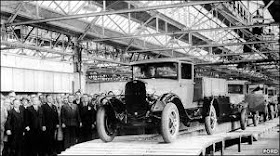 |
| Eric Dawson in his late 80's |
These paintings are normally hidden from public view, in the
stack of the reference library and archives. Many of the paintings are specifically of our
local area and we felt that they deserved a more permanent public viewing.
 |
| Last train leaving Forest Gate station |
We are grateful to Newham Library service, to whom Eric
donated many of the paintings and to Eric and his family for being able to present
them. It should be made very clear that the paintings are the copyright of
Newham and Eric's family, who we are sure will be glad that they can be shared with a wider
public than who normally has access to them.
 |
| Sunday evening in Upton Lane |
Eric was born in Forest Gate in 1918, and was educated at
West Ham Secondary school and West Ham School of Art. On the outbreak of war in
1939 he joined the armed forces, serving for almost five years.
 |
| Sunday School anniversary, Woodgrange Baptist church, early 1930's |
After the war he joined Carlton Artists as a designer - six
years later moving into women's magazines, first as Art Director of Homes and
Gardens and later as Art Director to the Women's Own Group.
 |
| Woolworth's in Green Street |
He later moved back to press and TV advertising, finally
freelancing and working for a range of top-ranking agencies and high street
companies.
 |
| Looking Back |
On retirement, in 1988, he began to bring some of the
memories of his earlier life back, with a series of watercolor paintings,
exhibiting at the National Army Museum, Epping Forest District Museum - where
he lived latterly - and about 20 other locations around London.
 |
| Grandfather and Eric Dawson, in the kitchen |
Eric donated 42 paintings to Newham Council about a decade
ago, all under the theme Growing up in East London 1918 -1939. To celebrate
the donation, Newham Council published his memoir Looking Back, in
2006, which basically provided a commentary to the donated paintings.
 |
| The house Eric Dawson was born, 6 Beauchamp Road |
Eric was born at the very end of World War 1, but never knew
his father, who died following a gas attack in the trenches.
 |
| Children watching Dawson's fish van leaving Beauchamp Road for their shop in Woodgrange Road |
The Introduction to Looking Back says of it:
He evokes a comfortable but nor
really wealthy Forest Gate of close-knit families and helpful neighbours. There
are some chain stores on the busier streets, but every neighbourhood has its
small privately-owned shops - butcher, grocer, sweet shop, boot and shoe
repairer, oil shop - providing necessities on a daily basis.
 |
| Coffee stall by Forest Gate clock |
Sunday schools and Temperance
meetings attracted large audiences and it was not unusual for a cinema to seat
3,000 people. At home, evening parties included poetry recitals and songs around
the piano. He described families travelling on the criss-cross of local railway
lines to spend holidays at seaside resorts where the lodgings were modest, but
the home cooking superb.
 |
| Horswills were builders in Green Street |
Eric described his Forest Gate
origins at the start of his memoir, thus:
In 1890, two
brothers, joining an accelerating movement away from the overcrowded eastern
districts of the City of London, left Bow for Forest Gate. They brought adjoining
houses in Beauchamp Road, leasehold for around £200 each. The elder brother was
my grandfather, William Robert Buck, the other my great uncle, Arthur. Both
were recently married. ...
 |
| Grandfather with Eric Dawson |
In the early
days of the 1920's it seemed as if every other road in Forest Gate was lined
with shops. The main thoroughfares, heavy with traffic, much of it still
horse-drawn, contained the larger establishments - Woolworth's, The Penny
Bazaar, Home and Colonial, the Co-op. Lots of dress shops, haberdashers and milliners,
Freeman, Hardy and Willis (shoes), Montague Burton, 'the tailor of taste'.
 |
| Dolls' hospital, by Forest Gate station |
The back
streets provided the daily necessities of the local inhabitants. Just around
the corner from us in St George's Road, a group of such local shops existed ...
 |
| Kenner -tailor of taste, 36 - 38 Upton Lane, painted in 1998 |
Within five
minutes walk was West Ham Park. Here we sped our scooters along smooth asphalt
paths, and in the summer learned to play cricket (underarm bowling) in the
shades of the leafy chestnut trees. The flower gardens splendidly maintained by
the City of London Corporation, were patrolled by stern park keepers, with
whistles. Close by was Upton Lane school, which all the family at various times
attended. ...
 |
| Two Sikh men, by the Gurney memorial in West Ham Park |
Further north,
along Upton Lane, occupying a whole block, was the Forest Gate Sanitary Steam Laundry.
The establishment ejected vast clouds of steam across Upton Lane; at night the
dramatic effect was enhanced by powerful but flickering arc lights illuminating
work areas. Sounds of heavy machinery rent the air, occasionally interspersed
with women's voices, raised in song, a truly Wagnerian manifestation. ...
 |
| Forest Gate Steam Laundry, Upton Lane |
On the far
side of West Ham Park was a large house called The Cedars, once the home of the
Gurney family (ed: Elizabeth Fry, principally).
It was now used by the local Territorials and by the British legion, the
ex-servicemen's club ... Outside The Cedars several horse brakes were drawn
up, decorated all over with flowers and favours and were filling up with
excited children, the atmosphere distinctly of the knees-up variety. ...
 |
| Intermission, Broadway Theatre, Stratford |
Looking
Back - Growing up in East London (1918 - 1939) by Eric Dawson, published by
Newham Council 2006, £7.99





















